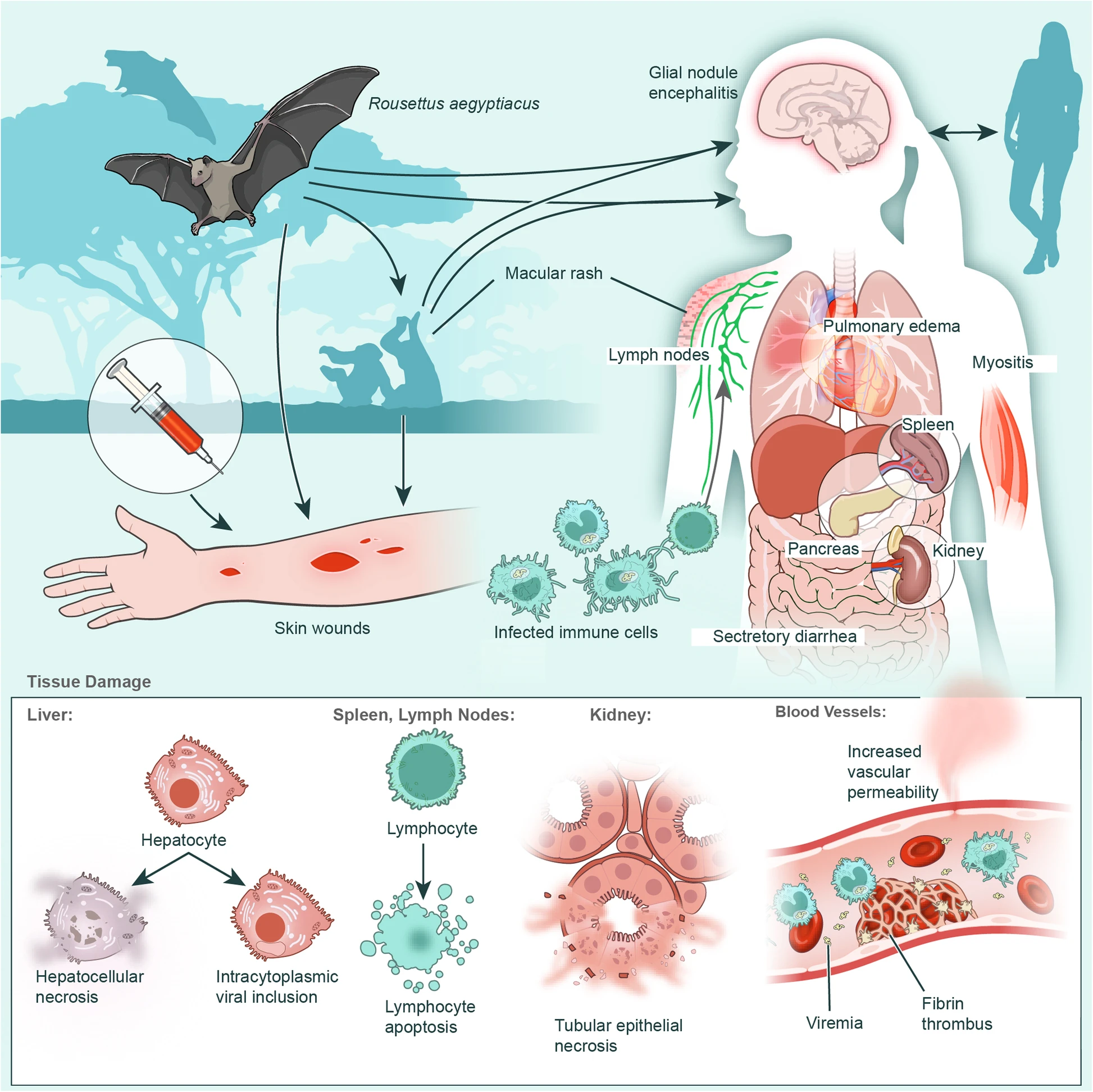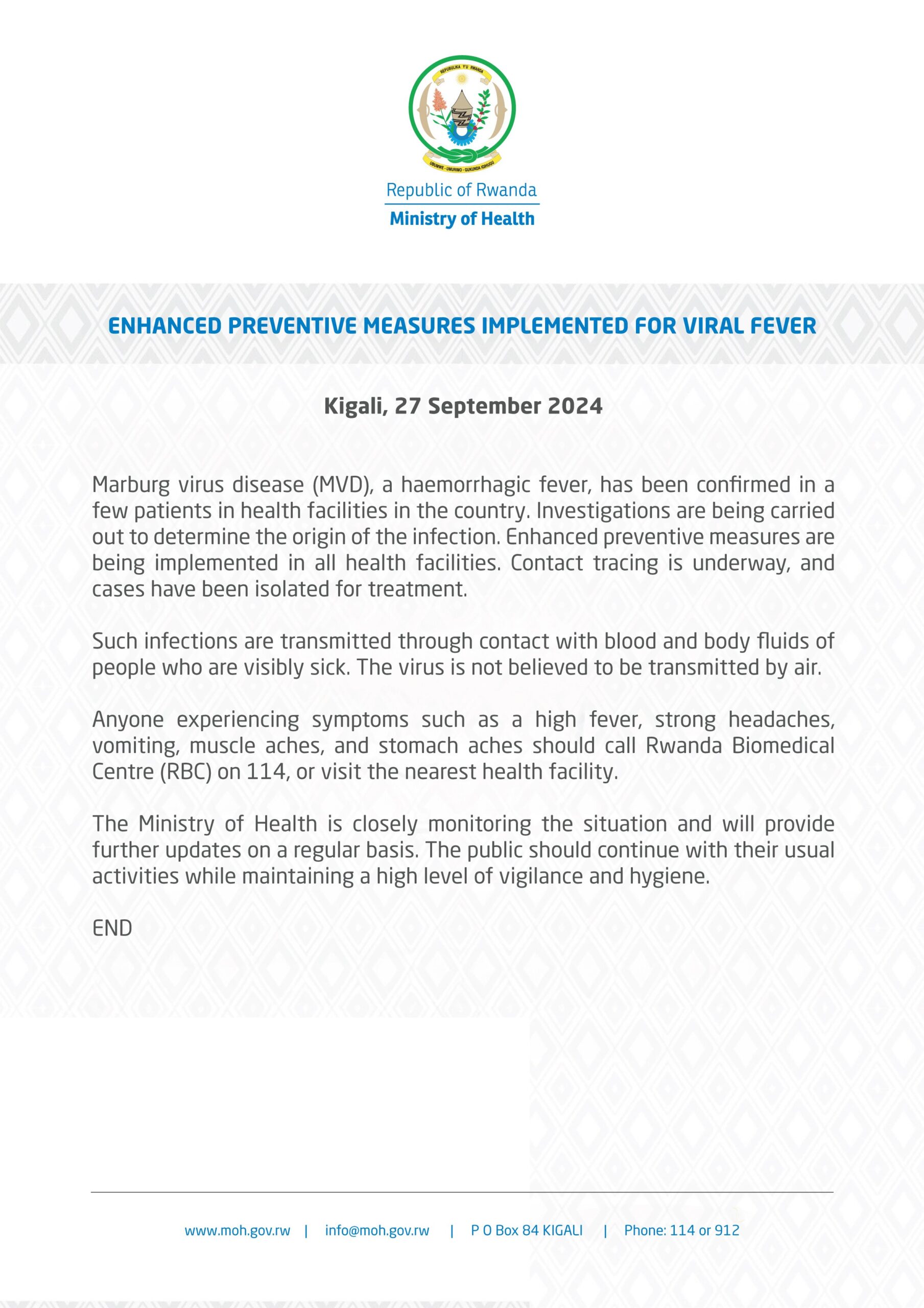
MARV pathogenesis in humans. Transmission and virus spread in the human body are depicted./Virology Journal.
Rwanda has confirmed the presence of the Marburg virus disease (MVD), after several cases of the deadly hemorrhagic fever were recorded in the country, amid claims of infections among health workers.
The confirmation by the Ministry of Health on Friday follows several reports circulating on social media about a deadly viral disease in the country, which comes on the heels of the Monkeypox Virus, which the country remains on the alert for. Officials say contact tracing is ongoing and identified cases have been isolated for treatment.
The Ministry of Health in a statement issued Friday said enhanced preventive measures will be implemented for the viral disease which produces a highly virulent hemorrhagic fever, with a fatality ratio of up to 88 percent. It is in the same family as the virus that causes Ebola.
“Marburg virus disease (MVD), a haemorrhagic fever, has been confirmed in a few patients in health facilities in the country. Investigations are being carried out to determine the origin of the infection,” the Ministry said.

The Ministry of Health confirmed the presence of the Marburg virus in Rwanda on Friday.
“Enhanced preventive measures are being implemented in all health facilities. Contact tracing is underway, and cases have been isolated for treatment. Such infections are transmitted through contact with blood and body fluids of people who are visibly sick. The virus is not believed to be transmitted by air,” the announcement said.
MoH further said that anyone experiencing symptoms such as a high fever, strong headaches, vomiting, muscle aches, and stomach aches should call Rwanda Biomedical Centre (RBC) on 114, or visit the nearest health facility.
“The Ministry of Health is closely monitoring the situation and will provide further updates on a regular basis. The public should continue with their usual activities while maintaining a high level of vigilance and hygiene,” the Ministry said, without addressing reports of fatalities in health facilities.
What you need to know about the Marburg Virus
The Marburg virus is named after two large outbreaks that occurred simultaneously in Marburg and Frankfurt in Germany, and in Belgrade, Serbia, in 1967, leading to the initial recognition of the disease. The outbreak was associated with laboratory work using African green monkeys (Cercopithecus aethiops) imported from Uganda.
Subsequently, outbreaks and sporadic cases have been reported in Angola, Democratic Republic of the Congo, Kenya, South Africa (in a person with recent travel history to Zimbabwe) and Uganda. In 2008, two independent cases were reported in travellers who visited a cave inhabited by Rousettus bat colonies in Uganda.
According to the World Health Organisation (WHO), human infection with Marburg virus disease initially results from prolonged exposure to mines or caves inhabited by Rousettus bat colonies. Once an individual is infected with the virus, Marburg can spread through human-to-human transmission via direct contact (through broken skin or mucous membranes) with the blood, secretions, organs or other bodily fluids of infected people, and with surfaces and materials (e.g. bedding, clothing) contaminated with these fluids.
Symptoms of Marburg
Illness caused by Marburg virus begins abruptly, with high fever, severe headache and severe malaise. Muscle aches and pains are a common feature, according to WHO.
Severe watery diarrhoea, abdominal pain and cramping, nausea and vomiting can begin on the third day. Diarrhoea can persist for a week. The appearance of patients at this phase has been described as showing “ghost-like” drawn features, deep-set eyes, expressionless faces and extreme lethargy. A non-itchy rash has been noted between 2 and 7 days after the onset of symptoms.
Many patients develop severe haemorrhagic manifestations within 7 days, and fatal cases usually have bleeding, often from multiple areas. Fresh blood in vomitus and faeces is often accompanied by bleeding from the nose, gums and vagina. Spontaneous bleeding at venipuncture sites (where intravenous access is obtained to give fluids or obtain blood samples) can be particularly troublesome.
During the severe phase of illness, patients have sustained high fevers. Involvement of the central nervous system can result in confusion, irritability and aggression. Orchitis (inflammation of the testicles) has been reported occasionally in the late phase (15 days). In fatal cases, death usually occurs between 8 and 9 days after onset, usually preceded by severe blood loss and shock.
Treating Marburg
There is as yet no proven treatment available for Marburg virus disease. However, supportive care – rehydration with oral or intravenous fluids – and treatment of specific symptoms improves survival. A range of potential treatments including blood products, immune therapies and drug therapies are currently being evaluated.
Diagnosis of Marburg is tricky. Experts say it can be difficult to clinically distinguish Marburg virus disease (MVD) from other infectious diseases such as malaria, typhoid fever, shigellosis, meningitis and other viral haemorrhagic fevers. Confirmation that symptoms are caused by Marburg virus infection are made using the several diagnostic methods using samples collected from patients are an extreme biohazard risk and laboratory testing on non-inactivated samples need to be conducted under maximum biological containment conditions.
All biological specimens must be packaged using the triple packaging system when transported nationally and internationally, according to WHO. Other outbreaks in recent years were recorded in Tanzania, Equatorial Guinea, Ghana, DRC and Uganda, among other countries.

